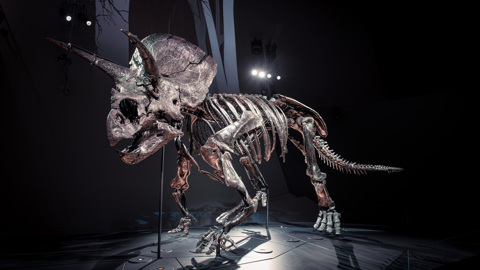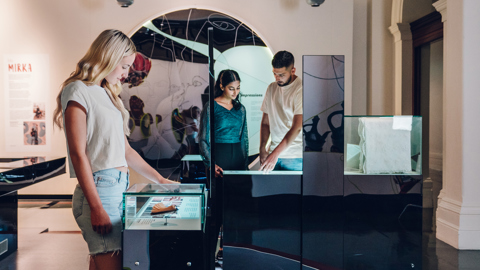
Theatre Studies
VCE Theatre Studies students interpret scripts and produce theatre for audiences. Through practical and theoretical engagement with scripts while planning, developing and presenting theatre, they gain insight into the processes and skills required to work in various production roles.
Students select a monologue from a prescribed list and explore the contexts of that script, including its time, place, culture, playwright, theatre styles, language and intended meanings. They consider the interrelationships between acting, direction and design.
The selection of works on display demonstrates outstanding design interpretations in the areas of costume, props, make-up, set, lighting and/or sound. Students who interpret their monologue through acting and directing are featured in the VCE Season of Excellence Top Class performances.
Clara Verbeek
Kew High School, Kew East
Wurundjeri Woi Wurrung Country
lorek Brynison (His Dark Materials, Nicholas Wright)
Costume and prop design: Vinyl fabric, cream and navy fabric, faux fur, papier-mache, wire, elastic, stuffing, hot glue, paint, foil, air dry clay, eyeshadow, thread
My interpretation of lorek Byrnison from His Dark Materials, Nicholas Wright's stage adaptation of the novel by Philip Pullman, was inspired by the conventions of Epic Theatre. Using symbolism to ensure human identification, this design was created to emphasise the emaciated and overworked status of lorek at the point in the play where the monologue is delivered. This is achieved through the skin-tight body suit, the addition of ribs on the outside of the body, the accentuated spine, and a polar bear skull over the actor's head. The latter symbolises for the audience the fact that Iorek has real human experiences. This layering references the manipulation, mistreatment and abuse enacted by European colonisers and encourages the audience to reflect on the historical impact that still exists today. Creating a prop that transforms from a bottle into 'Farder Coram's smoke leaf tin' symbolises the transformation in status that Iorek experiences during the play, and how addiction can be overcome and replaced by something new and beautiful.
Ewan Healy
Caulfield Grammar School, Wheelers Hill
Boon Wurrung Bunurong Country
Hamlet (Hamlet, William Shakespeare)
Set and costume design: Mirrored acrylic, pine, 50mm wheels, EVA foam, plastic, paint, screws, adhesive
My production design for William Shakespeare's Hamlet centres around the use of abstract imagery to portray this iconic play. The set pieces are designed in the shape of a crown, representative of Hamlet's right to rule over his usurping Uncle. With the aid of the seat, the set visually transforms from a more abstract reflection of Hamlet's destiny into a literal, yet still distinctly abstract throne. Each of the three set pieces can be moved on in-built wheels, allowing for dynamic set positioning throughout the play. To allow the set to move safely, the reflective panels of the piece are crafted from a mirrored acrylic substance, which gives the set rigidity while maintaining its lightweight profile. The costume design is far more emblematic of the play's narrative-driven context. There are three main pieces in Hamlet's costume: the coronet, breastplate and brigandine. The coronet is gilded with the same acrylic as the set and is reflective of Hamlet's shattered psyche at this point in the play. The breastplate incorporates the acrylic as well as leaves to represent Hamlet's connection to his father, who was killed in his own garden. This moment marks the beginning of the play and is therefore integral to the subtextual design of the costume.
Hannah Toniolo
Billanook College, Mooroolbark
Wurundjeri Woi Wurrung Country
Nellie (Salt Creek Murders, Melissa Reeves)
Set and costume design: Wooden sheets, paint, tree branches, screws, brackets, olive cotton fabric, lace
trimmings, plastic hoops, mesh fabric
The gruesome sadness surrounding the Myall Creek Massacre inspired the mood and symbolism in my designs. To create a sense of unease for the audience I blended styles of Gothic Horror and Realism. The scenery flats aimed to portray plastered walls and skirting that are accurate for the era, with abstract placement of native branches. The branches placed within brackets indicate the Australian bush context and emphasise its importance as a place. Nellie talks about how the plant Pigs Face grows and stains the fields like blood. To further the intended foreshadowing of murder, I incorporated a dead rabbit hanging from the kitchen wall. It is made of faux fur and stuffing, with liquid fake blood. The rabbit signifies Nellie’s rural lifestyle while further emphasising the motif of death. The flour sack works to further the kitchen context, foreshadowing Jane’s murder because they discover Jane’s body in a flour sack in the final scene. European female settlers in the 1850s wore dresses with large, hooped skirts. When designing and sewing the dress, I incorporated long sleeves that were common in clothing worn at home. The design is plain and simple, demonstrating the lower quality of dress worn when completing housework. The olive-green cotton used for the outer fabric is plain and echoes the bush hues. The apron is stained, emphasising the intended meaning that the house is stained from the violence. It works cohesively with the set to portray this idea.
Poppy Holden
Prahran High School, Windsor
Wurundjeri Woi Wurrung Country
Siobhan (The Curious Incident of the Dog in the Night-Time, Simon Stephens)
Set and prop design: Plywood, chipboard, pine, hinges, acrylic paint, electrical tape, mathematical grid
tape, envelopes, ink, paper, bias binding, book, cardboard boxes
Christopher Boone, the teenage protagonist of The Curious Incident of the Dog in the Night-Time, has intense interests: prime numbers, the Milky Way, A-Level Maths, red cars, and a dislike of the colours yellow and brown, among others. These visually informed my set and prop designs. A simple material palette and naïve renderings purposefully evoke childhood. The set design is demonstrated with a model of seven small cardboard boxes, and a sample full-size wooden box. Each face has a graph paper motif, some of them with an overlaid image that can be joined like a puzzle. The boxes support variation by allowing the actor to alter position and scale, and to suggest order or chaos. The designs of the properties include a vivid green book where Christopher writes the story (or play) of his investigation. Its colour and size provide prominence and signal narration to the audience. There are also letters, a single envelope and two garlands of 21 envelopes. Address fragments are stamped in ink, iconography suggests postal marks and the English setting, and the letter ‘Is’ have a distinctive circle. In this monologue, the discovery of 43 letters sent by Christopher’s mother after her supposed death is a pivotal moment of betrayal. To create emphasis, four boxes stack to form a large-scale envelope, and the garlands create volume and movement possibility.














